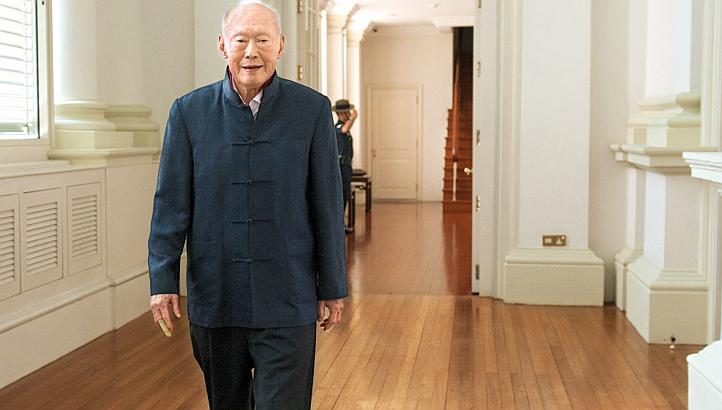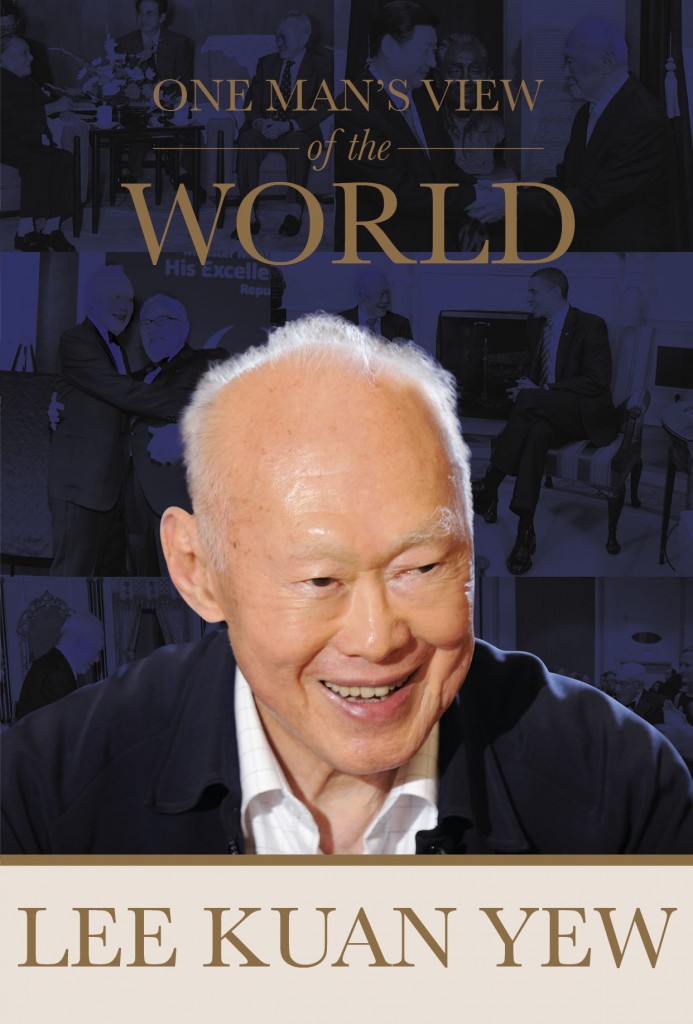Lee Kuan Yew, One Man’s View of the World
Singapore: Straits Times Press Holdings, 2013. Pp. 352, photographs, index.
Reviewed by Nina Ong.
In March 2007, when the Australian National University conferred an honorary degree on Lee Kuan Yew, protestors gathered with placards that implied that ANU was wrong to honour a leader whom many considered a “dictator” for his repressive measures to rein in the Singapore media and opposition. The New Mandala blog archive includes a number of insightful posts on the issue. Lee Kuan Yew’s reputation in the eyes of “Western publications” is not helped by his fiercely protective attitude towards his own legacy, which has resulted in him winning lawsuits in Singapore courts for alleged defamation in articles published in The Far Eastern Economic Review and The International Herald Tribune.
Nevertheless, Lee’s admirers continue to wax lyrical about him, viewing him as a “grand master” who, despite his small stage (my own native country, Singapore), has managed to impress world leaders and influence the policies of even a major power like China. A case in point would be Deng Xiaoping’s economic reforms, which, Lee implies in this book, One Man’s View of the World, was in part inspired by Deng’s exposure to Singapore’s economic success during his 1978 visit to the city-state. In fact, the book is peppered with anecdotes of Lee’s encounters with world leaders and his opinions of them. Of former PRC president Hu Jintao, he writes, for example, “Behind the benign, avuncular appearance, I think there is iron in the man.” (p. 32). It all leaves the reader with little doubt that Lee wrote One Man’s View of the World for people who regard him as a visionary leader whose analyses of international politics and perceptions of world leaders are to be taken seriously. The more critical reader, however, will hardly find comments like the one on Hu perceptive. The same might be said of a great number of politicians, including Hu’s predecessor Jiang Zemin or even the American vice president Joe Biden.
At the same time, if we can look beyond the sweeping views that one reviewer from Singapore calls “more entertaining than alarming or illuminating”, it is possible to gain fresh insight from One Man’s View of the World. How much readers gain from the book will depend on how they choose to read it. Like all autobiographical narratives, One Man’s View of the World tells us more about the man who wrote it than about the world that he observed.
Although not strictly an attempt to glorify the achievements of the man – a purpose better served by the pictorial book Lee Kuan Yew – A Life in Pictures, from the same publisher – One Man’s View of the World seems to be a publication whose timing betrays the intention further to justify the People’s Action Party’s response to the challenges that Singapore faces by emphasizing similar challenges faced by other countries. For example, it would be difficult for those familiar with politics in Singapore not to notice the parallels between the country’s struggle with low fertility rates and the matter of Japan’s ageing population, which is the focus of the book’s section on that country. Either Lee or his editors chose to title that section “Japan – Strolling into mediocrity”. Lee’s warning for Japan echoes his warning for Singapore. Of the former he writes, “Unless decisive action is taken very soon to resolve the population problem, no change in politics or economics could restore this nation to even a pale shadow of its post-war dynamism” (p. 129). Of Singapore, he asks rhetorically, “Is there a country in this world that prospers on a declining population?”, and then adds, “If I had to identify one issue that threatens Singapore the most, it would be this one” (p. 222).
Despite the fact that geopolitical issues in East Asia might be of greater concern than demography, especially to an international audience, these issues are only addressed in the last four pages of the discussion of Japan, and in a “Question and Answer” format.* Lee’s “answers” are brief compared to his treatise on Japan’s population problems.
One Man’s View of the World is unlikely to satisfy Lee’s critics because it lacks (again) absolutely any attempt to engage with their criticisms of him. Those who have read Lee Kuan Yew: Hard Truths to Keep Singapore Going (also from the same publisher), a thick volume on the economic realities to which Singapore must face up to survive as a country, will find the persona that Lee has created for himself in One Man’s View of the World familiar. Lee continues to style himself as the dispenser of “hard truths” – a pragmatic politician who is brutally frank and has no regrets about his past actions. Examples of this stance include his continued unapologetic embrace of the idea that a person’s capabilities are largely determined by his or her genes: “[India’s] caste system freezes the genetic pool within each caste” (p. 149). Or his revealing non-reply to a reporter’s question about the effects of privileges for Malaysia’s bumiputeras: “Where do you think the talent pool is?” (p. 170). Or his dismissal of the view that his “Stop at Two” policy might have contributed to the long-term low fertility rate in Singapore as an “absurd suggestion” (p. 218).
Previously criticized for being secretive about his family life, Lee (or perhaps his editors) now seeks to disarm critics by providing shockingly honest details, even when this does not seem terribly appropriate. The caption at the bottom of a page with a photograph of his family at the wedding of his eldest son, Singapore’s current Prime Minister Lee Hsien Loong, to Ho Ching – no doubt a happy occasion – says little about the bride. Instead, it is revealed that the “flower girl is Loong’s daughter Xiuqi, whose mother Wong Ming Yang died of a heart attack in 1982 at the age of 31”. It is as if Lee is saying, “There, everything’s accounted for.” Judging from the responses to his book in Singapore, both on-line and off-line, it appears that he has mastered, in writing, the art of being frank to the point of political incorrectness, while deftly deflecting further discussion of thorny topics. Nevertheless, his critics in Singapore should still read this book, not least because the book will provide them with an understanding of Lee’s perception of Singapore’s place in the global economy, which is crucial for anyone who seeks to offer a sound critique of Lee’s policies in Singapore, many of which are being continued by the current PAP government under his son, Lee Hsien Loong.
Younger Singaporeans, too, should read One Man’s View of the World, as should those interested in Singapore’s position on foreign policy issues. For the book does offer a broad perspective on world politics and quite successfully places Singapore in the context of an increasingly interdependent network of nation-states. Its succinct summaries of episodes in recent and not so recent history, such as Thaksin Chinnawat’s rise to power in Thailand or the Israeli-Palestinian conflict, provide enough background information for readers unfamiliar with the regions discussed in the book. However, a lack of in-depth analysis of the multiple historical factors that shaped the regions discussed also characterizes the book. For instance, on the topic of the Israeli-Palestinian conflict, British ambiguity in the 1917 Balfour Declaration is not addressed with Lee stating that the British “supported the settlement of Jews in Palestine with the view of eventually allowing them to form a Jewish state” and that the Balfour Declaration “formally set out this position” (p. 249). Yet it is relatively well known (indeed, it is in the ‘A’ levels History syllabus currently taught in Singapore’s schools) that the declaration, which Lee quoted, never mentions a “state” but a “national home” for the Jews. Thus, those with a serious interest in learning more about international politics should still refer to other sources to supplement their knowledge. Readers who are wondering why regions such as Latin America and Africa are omitted from the book might want to flip to page 308. In his reply to a journalist’s question on his regular reading, Lee says, “I follow closely on the Internet news on Singapore, the region, China, Japan, Korea, America, India and Europe. The Middle East – occasionally, Latin America – almost zero, because it is not relevant to us. Too far away.” Readers invested in the growing trade links between Latin America and Singapore need not be alarmed, however, because Lee is no longer in charge of the government. He is very much a retired political leader speaking from his past experiences.
On a more personal note, when thinking of Lee Kuan Yew, as a Singaporean, I remember two moments. As a primary school student in 1990, I watched on television the National Day Parade and teared when Lee sang the National Anthem at the parade for the last time as prime minister after three decades in power. To a primary school student, that seemed like forever. Even at the age of nine, I had learnt at school and at home that Lee was an extraordinary man and that his stepping down from power could be a turning point for my country, for better or for worse. The second moment was when there was a palpable sigh of relief in Singapore, and the National Stadium erupted in the loudest cheers for a PAP leader since the General Elections of 2011, when Lee, frail but still walking on his own, appeared at NDP 2012, thus squashing rumours on the Internet of his passing.
Judged against a modern critical yardstick, One Man’s View of the World may fall short. It reveals Lee Kuan Yew as a man who remains steadfast in his convictions, despite the fact that those convictions are influenced by ideas that many readers now may regard as archaic. For readers interested in international politics, there will be points of disagreement on controversial issues regarding Asia, America and Europe. But, for historians interested in Singapore history, the book does offer rich insights into the man, insights that will gain value through study of the cultural milieu of his formative years. Despite his prominence as a political leader, there is an unnatural dearth of academic writings on Lee Kuan Yew. One Man’s View of the World will certainly provide a rich source of information for future generations of scholars interested in analysing his leadership.
“Nina Ong” is the pseudonym of a graduate of the National University of Singapore who lives in her native country’s Bukit Merah neighbourhood.
Note
* We are told in a blurb that the Q&A sections of the book are “gleaned from conversations he [Lee} had with journalists from The Straits Times”. According to The Straits Times, the team of journalists and editors who helped to produce the book were also working together with Mr Shashi Jayakumar, the son of Singapore’s former Senior Minister, S. Jayakumar.
 Facebook
Facebook  Twitter
Twitter  Soundcloud
Soundcloud  Youtube
Youtube  Rss
Rss 
